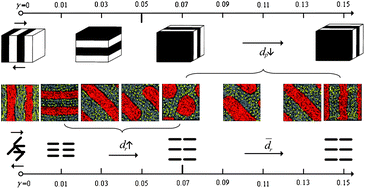Microphase transitions of block copolymer/nanorod composites under shear flow
Abstract
The shear-induced reorientations and phase transitions of symmetric

* Corresponding authors
a
Department of Physics, Zhejiang University, Hangzhou, P R China
E-mail:
lxzhang@zju.edu.cn
b Department of Physics, Wenzhou University, Wenzhou, P R China
c Department of Polymer Science and Engineering, University of Science and Technology of China, Hefei, Anhui, China
The shear-induced reorientations and phase transitions of symmetric

 Please wait while we load your content...
Something went wrong. Try again?
Please wait while we load your content...
Something went wrong. Try again?
L. He, Z. Pan, L. Zhang and H. Liang, Soft Matter, 2011, 7, 1147 DOI: 10.1039/C0SM00703J
To request permission to reproduce material from this article, please go to the Copyright Clearance Center request page.
If you are an author contributing to an RSC publication, you do not need to request permission provided correct acknowledgement is given.
If you are the author of this article, you do not need to request permission to reproduce figures and diagrams provided correct acknowledgement is given. If you want to reproduce the whole article in a third-party publication (excluding your thesis/dissertation for which permission is not required) please go to the Copyright Clearance Center request page.
Read more about how to correctly acknowledge RSC content.
 Fetching data from CrossRef.
Fetching data from CrossRef.
This may take some time to load.
Loading related content
